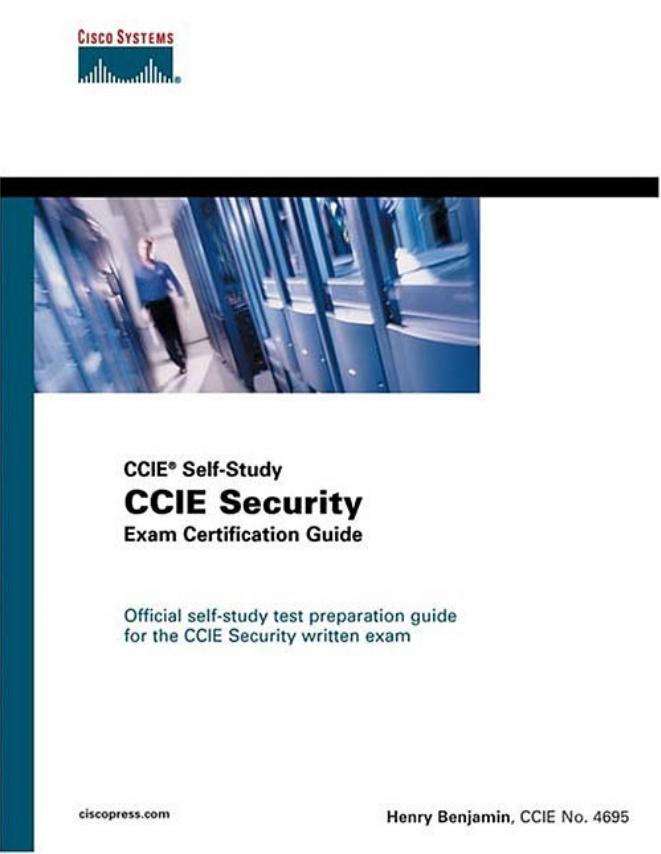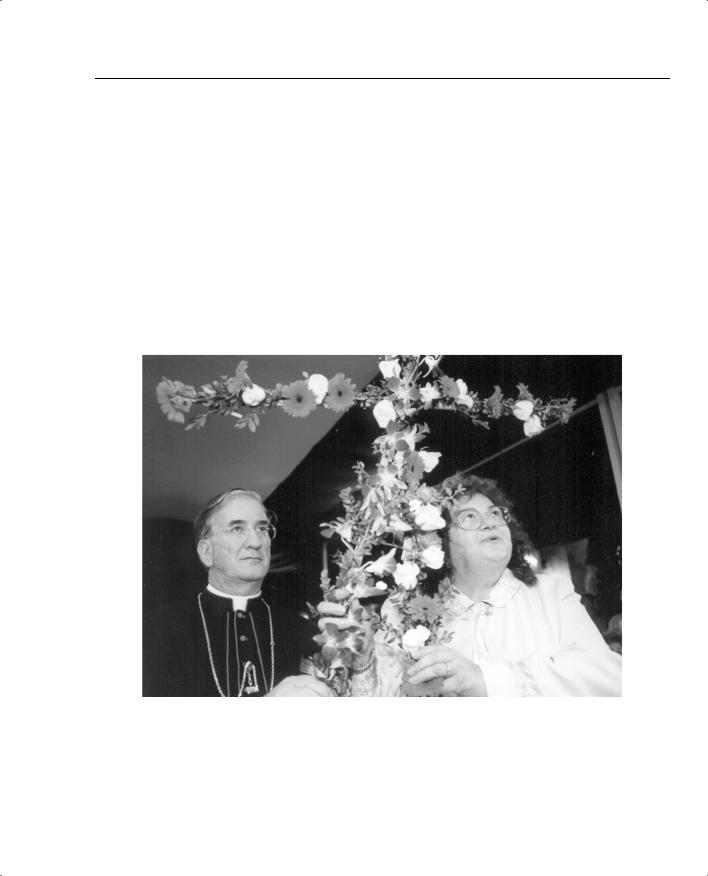
- •CCIE Security Written Exam Blueprint
- •General Networking Topics
- •“Do I Know This Already?” Quiz
- •Foundation Topics
- •Networking Basics—The OSI Reference Model
- •Ethernet Overview
- •Internet Protocol
- •Variable-Length Subnet Masks
- •Classless Interdomain Routing
- •Transmission Control Protocol
- •TCP Services
- •Routing Protocols
- •ISDN
- •IP Multicast
- •Asynchronous Communications and Access Devices
- •Foundation Summary
- •Requirements for FastEther Channel
- •Scenario
- •Scenario 2-1: Routing IP on Cisco Routers
- •Scenario Answers
- •Scenario 2-1 Answers: Routing IP on Cisco Routers
- •Application Protocols
- •“Do I Know This Already?” Quiz
- •Foundation Topics
- •Domain Name System
- •Trivial File Transfer Protocol
- •File Transfer Protocol
- •Hypertext Transfer Protocol
- •Secure Socket Layer
- •Simple Network Management Protocol
- •Simple Mail Transfer Protocol
- •Network Time Protocol
- •Secure Shell
- •Foundation Summary
- •Scenario
- •Scenario Answers
- •Scenario 3-1 Solutions
- •“Do I Know This Already?” Quiz
- •Foundation Topics
- •Cisco Hardware
- •show and debug Commands
- •Password Recovery
- •Basic Security on Cisco Routers
- •IP Access Lists
- •Foundation Summary
- •Scenario
- •Scenario Answers
- •Security Protocols
- •“Do I Know This Already?” Quiz
- •Foundation Topics
- •Authentication, Authorization, and Accounting (AAA)
- •Remote Authentication Dial-In User Service (RADIUS)
- •Kerberos
- •Virtual Private Dial-Up Networks (VPDN)
- •Encryption Technology Overview
- •Internet Key Exchange (IKE)
- •Foundation Summary
- •Scenario
- •Scenario 5-1: Configuring Cisco Routers for IPSec
- •Scenario Answers
- •Scenario 5-1 Solutions
- •“Do I Know This Already?” Quiz
- •Foundation Topics
- •UNIX
- •Microsoft NT Systems
- •Common Windows DOS Commands
- •Cisco Secure for Windows and UNIX
- •Cisco Secure Policy Manager
- •Cisco Secure Intrusion Detection System and Cisco Secure Scanner
- •Cisco Security Wheel
- •Foundation Summary
- •Scenarios
- •Scenario 6-1: NT File Permissions
- •Scenario 6-2: UNIX File Permissions
- •Scenario Answers
- •Scenario 6-1 Solution
- •Scenario 6-2 Solution
- •Security Technologies
- •“Do I Know This Already?” Quiz
- •Foundation Topics
- •Advanced Security Concepts
- •Cisco Private Internet Exchange (PIX)
- •Cisco IOS Firewall Security Feature Set
- •Public Key Infrastructure
- •Virtual Private Networks
- •Foundation Summary
- •Scenario
- •Scenario Answer
- •Scenario 7-1 Solution
- •“Do I Know This Already?” Quiz
- •Foundation Topics
- •Network Security Policies
- •Standards Bodies and Incident Response Teams
- •Vulnerabilities, Attacks, and Common Exploits
- •Intrusion Detection System
- •Protecting Cisco IOS from Intrusion
- •Foundation Summary
- •Scenario
- •Scenario 8-1: Defining IOS Commands to View DoS Attacks in Real Time
- •Scenario Answer
- •Scenario 8-1 Solution


CCIE Self-Study
CCIE Security Exam Certification
Guide
Henry Benjamin
Cisco Press
Cisco Press
201 West 103rd Street
Indianapolis, IN 46290 USA

ii
CCIE Self-Study
CCIE Security Exam Certification Guide
Henry Benjamin
Copyright © 2003 Cisco Systems, Inc.
Published by: Cisco Press
201 West 103rd Street Indianapolis, IN 46290 USA
All rights reserved. No part of this book may be reproduced or transmitted in any form or by any means, electronic or mechanical, including photocopying, recording, or by any information storage and retrieval system, without written permission from the publisher, except for the inclusion of brief quotations in a review.
Printed in the United States of America 1 2 3 4 5 6 7 8 9 0
First Printing April 2003
Library of Congress Cataloging-in-Publication Number: 2002104850
ISBN: 1-58720-065-1
Warning and Disclaimer
This book is designed to provide information about the CCIE Security written exam. Every effort has been made to make this book as complete and as accurate as possible, but no warranty or fitness is implied.
The information is provided on an “as is” basis. The authors, Cisco Press, and Cisco Systems, Inc., shall have neither liability nor responsibility to any person or entity with respect to any loss or damages arising from the information contained in this book or from the use of the discs or programs that may accompany it.
The opinions expressed in this book belong to the author and are not necessarily those of Cisco Systems, Inc.
Trademark Acknowledgments
All terms mentioned in this book that are known to be trademarks or service marks have been appropriately capitalized. Cisco Press or Cisco Systems, Inc. cannot attest to the accuracy of this information. Use of a term in this book should not be regarded as affecting the validity of any trademark or service mark.
Feedback Information
At Cisco Press, our goal is to create in-depth technical books of the highest quality and value. Each book is crafted with care and precision, undergoing rigorous development that involves the unique expertise of members from the professional technical community.
Readers’ feedback is a natural continuation of this process. If you have any comments regarding how we could improve the quality of this book, or otherwise alter it to better suit your needs, you can contact us through e-mail at feedback@ciscopress.com. Please make sure to include the book title and ISBN in your message.
We greatly appreciate your assistance.

iii
Publisher |
John Wait |
Editor-in-Chief |
John Kane |
Executive Editor |
Brett Bartow |
Cisco Representative |
Anthony Wolfenden |
Cisco Press Program Manager |
Sonia Torres Chavez |
Cisco Marketing Communications Manager |
Tom Geitner |
Cisco Marketing Program Manager |
Edie Quiroz |
Managing Editor |
Patrick Kanouse |
Development Editor |
Andrew Cupp |
Project Editor |
San Dee Phillips |
Copy Editor |
Marcia Ellett |
Technical Editors |
Gert De Laet, Anand Deveriya, |
|
Charles Resch, Gert Schauwers |
Team Coordinator |
Tammi Ross |
Book Designer |
Gina Rexrode |
Cover Designer |
Louisa Adair |
Compositor |
Octal Publishing, Inc. |
Indexer |
Brad Herriman |
Corporate Headquarters |
European Headquarters |
Americas Headquarters |
Asia Pacific Headquarters |
|
Cisco Systems, Inc. |
Cisco Systems Europe |
Cisco Systems, Inc. |
Cisco Systems Australia, |
|
170 West Tasman Drive |
11 Rue Camille Desmoulins |
170 West Tasman Drive |
Pty., Ltd |
|
San Jose, CA 95134-1706 |
92782 Issy-les-Moulineaux |
San Jose, CA 95134-1706 |
Level 17, 99 Walker Street |
|
USA |
|
Cedex 9 |
USA |
North Sydney |
http://www.cisco.com |
France |
http://www.cisco.com |
NSW 2059 Australia |
|
Tel: |
408 526-4000 |
http://www-europe.cisco.com |
Tel: 408 526-7660 |
http://www.cisco.com |
|
800 553-NETS (6387) |
Tel: 33 1 58 04 60 00 |
Fax: 408 527-0883 |
Tel: +61 2 8448 7100 |
Fax: |
408 526-4100 |
Fax: 33 1 58 04 61 00 |
|
Fax: +61 2 9957 4350 |
Cisco Systems has more than 200 offices in the following countries. Addresses, phone numbers, and fax numbers are listed on the Cisco Web site at www.cisco.com/go/offices
Argentina • Australia • Austria • Belgium • Brazil |
• Bulgaria • |
Canada • Chile • China • |
Colombia |
• Costa |
||||
Rica • Croatia • Czech Republic • Denmark • Dubai, UAE • Finland • France • Germany • Greece • Hong Kong |
||||||||
Hungary |
• India |
• Indonesia • Ireland • Israel • |
Italy • Japan • Korea • Luxembourg • |
Malaysia |
• |
Mexico |
||
The Netherlands • New |
Zealand • Norway • Peru • Philippines • Poland • Portugal • Puerto Rico • Romania |
|||||||
Russia • |
Saudi |
Arabia |
• Scotland • Singapore |
• Slovakia • |
Slovenia • South Africa |
• Spain |
• |
Sweden |
Switzerland • Taiwan • Thailand • Turkey • Ukraine • United Kingdom • United States • Venezuela • Vietnam Zimbabwe
Copyright © 2000, Cisco Systems, Inc. All rights reserved. Access Registrar, AccessPath, Are You Ready, ATM Director, Browse with Me, CCDA, CCDE, CCDP, CCIE, CCNA, CCNP, CCSI, CD-PAC, CiscoLink, the Cisco NetWorks logo, the Cisco Powered Network logo, Cisco Systems Networking Academy, Fast Step, FireRunner, Follow Me Browsing, FormShare, GigaStack, IGX, Intelligence in the Optical Core, Internet Quotient, IP/VC, iQ Breakthrough, iQ Expertise, iQ FastTrack, iQuick Study, iQ Readiness Scorecard, The iQ Logo, Kernel Proxy, MGX, Natural Network Viewer, Network Registrar, the Networkers logo, Packet, PIX, Point and Click Internetworking, Policy Builder, RateMUX, ReyMaster, ReyView, ScriptShare, Secure Script, Shop with Me, SlideCast, SMARTnet, SVX, TrafficDirector, TransPath, VlanDirector, Voice LAN, Wavelength Router, Workgroup Director, and Workgroup Stack are trademarks of Cisco Systems, Inc.; Changing the Way We Work, Live, Play, and Learn, Empowering the Internet Generation, are service marks of Cisco Systems, Inc.; and Aironet, ASIST, BPX, Catalyst, Cisco, the Cisco Certified Internetwork Expert Logo, Cisco IOS, the Cisco IOS logo, Cisco Press, Cisco Systems, Cisco Systems Capital, the Cisco Systems logo, Collision Free, Enterprise/Solver, EtherChannel, EtherSwitch, FastHub, FastLink, FastPAD, IOS, IP/TV, IPX, LightStream, LightSwitch, MICA, NetRanger, Post-Routing, Pre-Routing, Registrar, StrataView Plus, Stratm, SwitchProbe, TeleRouter, are registered trademarks of Cisco Systems, Inc. or its affiliates in the U.S. and certain other countries.
All other brands, names, or trademarks mentioned in this document or Web site are the property of their respective owners. The use of the word partner does not imply a partnership relationship between Cisco and any other company. (0010R)

iv
About the Author
Henry Benjamin, CCIE No.4695, holds three CCIE certifications, having attained Routing and Switching in May 1999, ISP Dial in June 2001, and Communications and Services in May 2002. He has more than 10 years experience with Cisco networks, including planning, designing, and implementing large IP networks running IGRP, EIGRP, BGP, and OSPF. Recently, Henry has worked for a large IT organization based in Sydney, Australia as a key Network Designer, designing and implementing networks all over Australia and Asia.
In the past two years, Henry has been a key member of the CCIE global team based in Sydney, Australia. As a senior and core member of the team, his tasks include writing new laboratory examinations and questions for the coveted CCIE R/S, CCIE Security, and CCIE C/S tracks, as well as the CCIE written Recertification Examinations. Henry has authored two other titles, “CCNP Practical Studies: Routing” (Cisco Press) and “CCIE R&S Exam Cram.”
Henry holds a Bachelor of Aeronautical Engineering degree from Sydney
University (1991).
About the Contributing Author
Gert De Laet, CCIE No. 2657, has both CCIE Security and Routing and Switching certifications. He has more than nine years of experience in internetworking. Gert currently works for the CCIE team at Cisco in Brussels, Belgium, as CCIE Proctor/Content Engineer and Program Manager for EMEA. He also holds an Engineering degree in Electronics.
Gert helped write Chapter 9 of this book and acted as a lead technical reviewer for the entire book.
About the Technical Reviewers
Anand Deveriya, CCIE No.10401, in Security and MCSE, has five years of LAN/WAN and network security experience with Cisco products. Currently, he is the Network Manager at Summerville Senior Living, where he designed and deployed their nationwide Frame Relay-based WAN network with VoIP. Additionally, he monitors the LAN/WAN security, penetration testing, and OS hardening. Prior to that, he was a network engineer with NEC, where he deployed scalable, secure, and redundant network backbone for dotcom and campus environments using Cisco routers, switches, PIX, and VPN products.
Charles Resch, CCIE No. 6582, currently works at Nuclio as a Senior Network Engineer, where he installs and configures management equipment to monitor customer networks. Among his projects are e-commerce sites with dual Cisco PIX Firewalls, Cisco Content Switch (CSS) load balancers, Intel and SonicWall SSL off-loaders, Cisco switches (HSRP-VLANs), and Cisco Secure Intrusion Detection Systems (CSIDS). Among other jobs, he has worked as a Senior Instructor at Information Technology Institute—Northwestern Business College, and as a Senior Internet Engineer at Globalcom Inc. He has extensive experience with Cisco hardware, Cisco IOS Software, numerous routed and routing protocols, and operating systems.
Gert Schauwers, CCIE No. 6924, has CCIE certifications in Security, Routing and Switching, and Communications and Services. He has more than four years of experience in internetworking. He is currently working for the CCIE team at Cisco in Brussels, Belgium, as CCIE Content Engineer. He has an Engineering degree in Electronics.

v
Dedication
This book is solely dedicated to two wonderful individuals whom I’ve had the pleasure of meeting on two occasions in my life. Without their inspiration and love for all humanity, I would not be here writing this book. I dedicate this book to His Excellency Monsignor, Claudio Gatti, and Marisa Rossi. I thank God for you.
“I am the Mother of the Eucharist. Know Jesus’ word. Love Jesus, the Eucharist.”
—Our Lady, Mary, Mother of the Eucharist
Questo libro è dedicato esclusivamente a due persone meravigliose che ho avuto il piacere di conoscere e incontrare in due occasioni nella mia vita. Senza la loro ispirazione e il loro amore per tutta l’umanità io non sarei qui a scrivere questo libro. Dedico questo libro a Sua Eccellenza Mons. Claudio Gatti e a Marisa Rossi.
“Io sono la madre dell’Eucaristia. Conoscete Gesù parola. Amate Gesù Eucaristia.”
—Madonna, Maria, Madre dell’Eucaristia

vi
Acknowledgments
I would like to thank the folks at Cisco Press for helping me and introducing me to this challenging project.
Brett Bartow, you are an amazing individual. Thank you for your wonderful insight and complete trust in me. Andrew Cupp, or Drew, as you are known to many of us, no bones about it, you are one of a kind; your editing and technical ability really astounded me, and without you, this book would not be the quality product it is now. No book on the market is as good as this one, thanks mate. Thank you for completing all the chapters with your wonderful touches. This book is better because of your input. The team at Cisco Press is an amazing family of hard-working people. It has been a true pleasure to be invited to write this book. Any inspired authors should only ever consider one publisher, Cisco Press. Thanks also to Tammi Ross, Tracy Hughes, and Ginny Bess for all your help. Thank you San Dee Phillips and Patrick Kanouse for your wonderful, final touches that made this book what readers see today.
The technical editors, Gert De Laet, Gert Schauwers, Anand Deveriya, and Charles Resch, provided valuable technical expertise and all have shown that they, too, can one day pursue a writing career, as I am sure they will in the near future. Gert De Laet, thank you, especially, for helping me write the security sections of Chapter 9. It was a real pleasure and honor to have you contribute to this book. Gert Schauwers, thank you for all the encouragement you gave me over the last twelve months. Loved that game of golf in San Jose.
Gert D. and Gert S., thank you for your true friendship.
To finish, I would also like to thank my wife, Sharon, and my one and only son, Simon (the spiderboy). I was always grateful to them both for understanding and knowing when I needed time to complete this project. I treasure my time with my family and my growing little boy who makes me proud to be his Dad. Simon, I love you to the sun, and keep going around forever and ever and watch out for the new Spider Boy movie. I also thank my Dad and Mum for bringing me up with such great examples, and my wife’s parents (Nana and Mate, plus Princess) for their encouragement over the last six months. Uncle Albert, keep making those beautiful donuts and thank you for your encouragement. Thank you to my beautiful sister, Melanie, for her wonderful love throughout my life. This year you become a registered nurse and passed your exams with distinctions. What a wonderful sister you are. I am so proud of you, Mel. Thanks Mello Yello. Massimo Piccinini, my physicist friend in the most beautiful City of the World, Roma, thank you for the friendship and love over the past five years; you are a truly amazing friend (amico).
I want to thank my wonderful aunties who gave me wonderful encouragement over all the years they have known me. Thank you, Aunty Lyda and Alice.

vii
Contents at a Glance
Foreword xv
Introduction xvi
Chapter 1 |
Using This Book to Prepare for the CCIE Security Written Exam 3 |
|||
Chapter 2 |
General Networking Topics |
11 |
|
|
Chapter 3 |
Application Protocols |
103 |
|
|
Chapter 4 |
Cisco IOS Specifics and Security 145 |
|
||
Chapter 5 |
Security Protocols 199 |
|
|
|
Chapter 6 |
Operating Systems and Cisco Security Applications 279 |
|||
Chapter 7 |
Security Technologies |
315 |
|
|
Chapter 8 |
Network Security Policies, Vulnerabilities, and Protection 361 |
|||
Chapter 9 |
CCIE Security Self-Study Lab 391 |
|
||
Appendix A |
Answers to Quiz Questions |
489 |
|
|
Appendix B |
Study Tips for CCIE Security Examinations |
569 |
||
Appendix C |
Sample CCIE Routing and Switching Lab |
583 |
||
Index 599 |
|
|
|
|

viii
Table of Contents
Foreword xvi
Introduction xvii
Conclusion xxi
Chapter 1 Using This Book to Prepare for the CCIE Security Written Exam 3
CCIE Security Certification |
4 |
|
|
|
||
CCIE Security Written Exam Blueprint |
4 |
|||||
How to Prepare for the CCIE Security Written Exam Using This Book 7 |
||||||
Chapter 2 General Networking Topics |
11 |
|
|
|
||
“Do I Know This Already?” Quiz |
12 |
|
||||
Foundation Topics |
21 |
|
|
|
|
|
Networking Basics—The OSI Reference Model 21 |
||||||
Layer 1: The Physical Layer |
21 |
|
||||
Layer 2: The Data Link Layer |
22 |
|
||||
Layer 3: The Network Layer |
23 |
|
||||
Layer 4: The Transport Layer 24 |
|
|||||
Layer 5: The Session Layer |
24 |
|
||||
Layer 6: The Presentation Layer |
24 |
|
||||
Layer 7: The Application Layer |
25 |
|
||||
TCP/IP and OSI Model Comparison |
25 |
|||||
Example of Peer-to-Peer Communication 25 |
||||||
Ethernet Overview |
27 |
|
|
|
|
|
Switching and Bridging |
28 |
|
|
|
||
Bridge Port States |
31 |
|
|
|
|
|
FastEther Channel |
31 |
|
|
|
|
|
Internet Protocol |
33 |
|
|
|
|
|
Variable-Length Subnet Masks |
38 |
|
||||
Classless Interdomain Routing |
39 |
|
|
|||
Transmission Control Protocol |
40 |
|
|
|||
TCP Mechanisms |
41 |
|
|
|
|
|

ix
TCP Services |
45 |
|
|
|
|
|
|
||
Address Resolution Protocol (ARP) 45 |
|
||||||||
Reverse ARP |
46 |
|
|
|
|
|
|||
Dynamic Host Configuration Protocol |
46 |
|
|||||||
Hot Standby Router Protocol |
47 |
|
|
|
|||||
Internet Control Message Protocol |
52 |
|
|
||||||
Telnet |
53 |
|
|
|
|
|
|
||
File Transfer Protocol and Trivial File Transfer Protocol 53 |
|||||||||
Routing Protocols |
53 |
|
|
|
|
|
|||
Routing Information Protocol |
57 |
|
|
|
|||||
EIGRP |
62 |
|
|
|
|
|
|
||
OSPF |
66 |
|
|
|
|
|
|
|
|
Border Gateway Protocol |
76 |
|
|
|
|
||||
ISDN |
79 |
|
|
|
|
|
|
|
|
Basic Rate and Primary Rate Interfaces |
80 |
|
|||||||
ISDN Framing and Frame Format |
80 |
|
|
||||||
ISDN Layer 2 Protocols |
80 |
|
|
|
|
||||
Cisco IOS ISDN Commands |
82 |
|
|
|
|||||
IP Multicast |
83 |
|
|
|
|
|
|
||
Asynchronous Communications and Access Devices |
84 |
||||||||
Foundation Summary 87 |
|
|
|
|
|
||||
Requirements for FastEther Channel |
89 |
|
|
||||||
Q & A |
93 |
|
|
|
|
|
|
|
|
Scenario |
99 |
|
|
|
|
|
|
|
|
Scenario 2-1: Routing IP on Cisco Routers |
99 |
|
|||||||
Scenario Answers |
101 |
|
|
|
|
|
|||
Scenario 2-1 Answers: Routing IP on Cisco Routers |
101 |
||||||||
Chapter 3 Application Protocols 103
“Do I Know This Already?” Quiz 103
Foundation Topics 110
Domain Name System 110
Trivial File Transfer Protocol 113

x
File Transfer Protocol |
115 |
|
|
|
|||
Active FTP |
116 |
|
|
|
|
||
Passive FTP |
117 |
|
|
|
|
||
Hypertext Transfer Protocol |
118 |
|
|
||||
Secure Socket Layer |
120 |
|
|
|
|||
Simple Network Management Protocol |
121 |
||||||
SNMP Notifications |
122 |
|
|
||||
SNMP Examples |
126 |
|
|
|
|||
Simple Mail Transfer Protocol 127 |
|
||||||
Network Time Protocol |
128 |
|
|
|
|||
Secure Shell 132 |
|
|
|
|
|
||
Foundation Summary |
134 |
|
|
|
|||
Q & A |
136 |
|
|
|
|
|
|
Scenario |
140 |
|
|
|
|
|
|
Scenario 3-1: Configuring DNS, TFTP, NTP, and SNMP 140 |
|||||||
Scenario Answers 142 |
|
|
|
||||
Scenario 3-1 Solutions |
142 |
|
|
|
|||
Chapter 4 Cisco IOS Specifics and Security |
145 |
||||||
“Do I Know This Already?” Quiz |
145 |
||||||
Foundation Topics |
150 |
|
|
|
|||
Cisco Hardware |
150 |
|
|
|
|
||
Random-Access Memory (RAM) |
151 |
||||||
Nonvolatile RAM (NVRAM) |
151 |
|
|||||
System Flash |
151 |
|
|
|
|
||
Central Processing Unit |
152 |
|
|
||||
Read-Only Memory |
153 |
|
|
||||
Configuration Registers |
154 |
|
|
||||
Cisco Interfaces |
156 |
|
|
|
|||
Saving and Loading Files |
158 |
|
|
||||
show and debug Commands |
159 |
|
|
||||
Router CLI |
159 |
|
|
|
|
|
|
show Commands |
159 |
|
|
|
|||
Debugging Cisco Routers |
168 |
|
|
||||

xi
Password Recovery |
174 |
|
|
|
|||
Basic Security on Cisco Routers |
179 |
|
|
||||
IP Access Lists |
182 |
|
|
|
|
||
Access Lists on Cisco Routers |
182 |
|
|||||
Extended Access Lists 187 |
|
|
|
||||
Foundation Summary |
191 |
|
|
|
|||
Q & A |
193 |
|
|
|
|
|
|
Scenario |
195 |
|
|
|
|
|
|
Scenario 4-1: Configuring Cisco Routers for Passwords and Access Lists 195 |
|||||||
Scenario Answers |
197 |
|
|
|
|||
Chapter 5 Security Protocols |
|
199 |
|
|
|
||
“Do I Know This Already?” Quiz |
199 |
|
|||||
Foundation Topics |
208 |
|
|
|
|||
Authentication, Authorization, and Accounting (AAA) |
208 |
||||||
Authentication |
210 |
|
|
|
|||
Authorization |
|
210 |
|
|
|
||
Accounting |
211 |
|
|
|
|
||
Remote Authentication Dial-In User Service (RADIUS) |
212 |
||||||
RADIUS Configuration Task List |
215 |
|
|||||
Terminal Access Controller Access Control System Plus (TACACS+) 218 |
|||||||
TACACS+ Configuration Task List |
220 |
|
|||||
TACACS+ Versus RADIUS |
224 |
|
|
||||
Kerberos |
225 |
|
|
|
|
|
|
Kerberos Configuration Task List |
228 |
|
|||||
Virtual Private Dial-Up Networks (VPDN) 229 |
|
||||||
VPDN Configuration Task List 232 |
|
||||||
Encryption Technology Overview |
235 |
|
|||||
Data Encryption Standard (DES) and Triple Data Encryption |
|||||||
Standard (3DES) |
237 |
|
|
|
|||
Digital Signature Standard (DSS) |
238 |
|
|||||
Message Digest 5 (MD5) and Secure Hash Algorithm (SHA) 239 |
|||||||
Diffie-Hellman |
240 |
|
|
|
|||
IP Security IPSec |
242 |
|
|
|
|||

xii
Internet Key Exchange (IKE) |
246 |
|
|
|||
IKE Phase I Messages Types 1-6 |
247 |
|||||
IKE Phase II Message Types 1-3 |
248 |
|||||
Cisco IOS IPSec Configuration |
252 |
|||||
Certificate Enrollment Protocol (CEP) |
259 |
|||||
Foundation Summary |
260 |
|
|
|
||
Q & A |
265 |
|
|
|
|
|
Scenario |
271 |
|
|
|
|
|
Scenario 5-1: Configuring Cisco Routers for IPSec 271 |
||||||
Scenario Answers |
275 |
|
|
|
||
Scenario 5-1 Solutions |
275 |
|
|
|
||
Chapter 6 Operating Systems and Cisco Security Applications 279 |
||||||
“Do I Know This Already?” Quiz |
279 |
|||||
Foundation Topics |
284 |
|
|
|
||
UNIX |
284 |
|
|
|
|
|
UNIX Command Structure |
285 |
|
||||
UNIX Permissions |
288 |
|
|
|
||
UNIX File Systems |
289 |
|
|
|
||
Microsoft NT Systems |
290 |
|
|
|
||
Browsing and Windows Names Resolution 291 |
||||||
Scaling Issues in Windows NT |
292 |
|||||
Login and Permissions 293 |
|
|
||||
Windows NT Users and Groups |
294 |
|||||
Windows NT Domain Trust |
294 |
|
||||
Common Windows DOS Commands |
295 |
|||||
Cisco Secure for Windows and UNIX |
297 |
|||||
Cisco Secure Policy Manager |
299 |
|
|
|||
Cisco Secure Intrusion Detection System and Cisco Secure Scanner 299 NetRanger (Cisco Secure Intrusion Detection System) 300 NetSonar (Cisco Secure Scanner) 302
Cisco Security Wheel |
304 |
Foundation Summary |
305 |

xiii
Q & A 308 |
|
Scenarios 311 |
|
Scenario 6-1: NT File Permissions 311 |
|
Scenario 6-2: UNIX File Permissions 311 |
|
Scenario Answers 312 |
|
Scenario 6-1 Solution |
312 |
Scenario 6-2 Solution |
312 |
Chapter 7 Security Technologies |
315 |
|
|
|
|||
“Do I Know This Already?” Quiz |
315 |
|
|||||
Foundation Topics |
320 |
|
|
|
|
||
Advanced Security Concepts 320 |
|
|
|
||||
Network Address Translation and Port Address Translation 324 |
|||||||
NAT Operation on Cisco Routers |
326 |
||||||
Cisco Private Internet Exchange (PIX) |
328 |
||||||
Configuring a PIX |
332 |
|
|
|
|||
Cisco PIX Firewall Software Features |
342 |
||||||
Cisco IOS Firewall Security Feature Set |
344 |
||||||
CBAC Configuration Task List |
346 |
|
|||||
Public Key Infrastructure |
348 |
|
|
|
|||
Virtual Private Networks |
349 |
|
|
|
|||
Foundation Summary |
352 |
|
|
|
|||
Q & A |
355 |
|
|
|
|
|
|
Scenario |
358 |
|
|
|
|
|
|
Scenario 7-1: Configuring a Cisco PIX for NAT 358 |
|||||||
Scenario Answer |
359 |
|
|
|
|
|
|
Scenario 7-1 Solution |
359 |
|
|
|
|||

xiv
Chapter 8 Network Security Policies, Vulnerabilities, and Protection 361 |
|
||||||||
“Do I Know This Already?” Quiz |
361 |
|
|
||||||
Foundation Topics |
365 |
|
|
|
|
|
|
||
Network Security Policies |
365 |
|
|
|
|
||||
Standards Bodies and Incident Response Teams |
366 |
|
|||||||
Incident Response Teams |
367 |
|
|
|
|
||||
Internet Newsgroups |
368 |
|
|
|
|
||||
Vulnerabilities, Attacks, and Common Exploits |
369 |
|
|||||||
Intrusion Detection System |
372 |
|
|
|
|
||||
Protecting Cisco IOS from Intrusion |
375 |
|
|
||||||
Foundation Summary |
381 |
|
|
|
|
|
|||
Q & A |
384 |
|
|
|
|
|
|
|
|
Scenario |
387 |
|
|
|
|
|
|
|
|
Scenario 8-1: Defining IOS Commands to View DoS Attacks in Real Time |
387 |
||||||||
Scenario Answer |
388 |
|
|
|
|
|
|
|
|
Scenario 8-1 Solution |
388 |
|
|
|
|
|
|||
Chapter 9 CCIE Security Self-Study Lab |
391 |
|
|
|
|||||
How to Use This Chapter |
391 |
|
|
|
|
||||
Goal of This Lab |
391 |
|
|
|
|
|
|
|
|
CCIE Security Self-Study Lab Part I Goals |
392 |
|
|||||||
CCIE Security Self-Study Lab Part II Goals |
393 |
|
|||||||
General Lab Guidelines and Setup |
393 |
|
|
||||||
Communications Server |
396 |
|
|
|
|
||||
CCIE Security Self-Study Lab Part I: Basic Network Connectivity (4 Hours) |
397 |
||||||||
Basic Frame Relay Setup |
397 |
|
|
|
|
||||
Physical Connectivity |
403 |
|
|
|
|
||||
Catalyst Ethernet Switch Setup I |
|
403 |
|
|
|||||
Catalyst Ethernet Switch Setup II |
408 |
|
|
||||||
IP Host Lookup and Disable DNS |
414 |
|
|
||||||
PIX Configuration |
414 |
|
|
|
|
|
|||
IGP Routing |
419 |
|
|
|
|
|
|
|
|
Basic ISDN Configuration 432

xv
|
DHCP Configuration |
438 |
|
|
|
|
|
BGP Routing Configuration |
439 |
|
|
||
|
CCIE Security Self-Study Lab Part II: Advanced Security Design (4 Hours) 442 |
|||||
|
IP Access List 442 |
|
|
|
|
|
|
Prevent Denial-of-Service Attacks |
444 |
|
|||
|
Time-Based Access List |
446 |
|
|
|
|
|
Dynamic Access List/Lock and Key Feature |
448 |
||||
|
IOS Firewall Configuration on R5 |
450 |
|
|||
|
IPSec Configuration |
452 |
|
|
|
|
|
Advanced PIX Configuration |
458 |
|
|
||
|
ACS Configuration |
461 |
|
|
|
|
|
Final Configurations 470 |
|
|
|
|
|
|
Conclusion 486 |
|
|
|
|
|
Appendix A |
Answers to Quiz Questions |
489 |
|
|
||
Appendix B |
Study Tips for CCIE Security Examinations |
569 |
||||
Appendix C |
Sample CCIE Routing and Switching Lab 583 |
|||||
Index 599 |
|
|
|
|
|
|

xvi
Foreword
The CCIE program is designed to help individuals, companies, industries, and countries succeed in the networked world by distinguishing the top echelon of internetworking experts. In particular, the CCIE Security Certification is designed to identify network security experts.
The first step along the CCIE Security path is for individuals to take a challenging written exam designed to assess their knowledge across a range of technologies. If their scores indicate expert-level knowledge, candidates then proceed to a performance-based CCIE Security Certification Lab Exam.
Why Security Certifications?
Security is one of the fastest-growing areas in the industry. The expansive development of the Internet, the increase in e-business, and the escalating threat to both publicand private-sector networks have made security and the protection of information a primary concern for all types of organizations. An ever-increasing demand exists for the experts with the knowledge and skills to do it. Therefore, trained network security personnel will be required in the years to come.
Why CCIE Security?
CCIE Security distinguishes the top level of network security experts. The CCIE Security Certification enables individuals to optimize career growth, opportunity, and compensation by distinguishing themselves as being part of the network security experts of the world.
The CCIE Security Certification enables companies to minimize their risk by identifying the highest caliber of security personnel with the training and skills necessary to protect their critical information assets.
This book will be a valuable asset to potential CCIE Security candidates. I am positive individuals will gain extensive security network knowledge during their preparation for the CCIE Security written exam using this book. The book’s main focus is providing an in-depth description of the various security features and an understanding of, and ability to navigate, the subtleties, intricacies, and potential pitfalls inherent to networking security. This book and accompanying CD-ROM contain many tools to strongly supplement your preparation for CCIE Security certification.
Good Luck!
Gert De Laet
Product Manager CCIE Security
Cisco Systems, Inc.

xvii
Introduction
The Cisco Certified Internet Expert Security Certification is an increasingly popular internetworking certification and one of the most popular security certifications in the world. Although CCIE certification builds on the foundation you might have established from the Cisco Certified Network Associate (CCNA) and Cisco Certified Network Professional (CCNP) certifications, there is no prerequisite to attempt to gain CCIE certification. However, attaining CCNA and CCNP certifications will help you understand Cisco subjects and testing strategies.
This book is designed to help you prepare for the CCIE Security written exam (Exam #350-018). It will also help prepare you for the CCIE Security Recertification exam (Exam #350-009).
Cisco released the Security CCIE track in 2001, and its popularity has grown to such an extent that Cisco is investing more heavily in this track than any other current CCIE track.
To achieve CCIE Security certification, you must pass a written exam and a one-day lab exam. To qualify for the CCIE Security lab examination, you must first successfully pass the written exam. Both examinations are difficult, and this book is primarily aimed at helping you prepare for the written exam. Chapter 9 includes a CCIE Security self-study lab that helps you with comprehensive preparation for the written exam and gives you an idea of the challenges you will face in the lab exam.
Cisco makes achieving CCIE Security certification intentionally difficult. No one book can prepare you for the exam. You should have extensive practical experience and consult many resources. This will give you a comprehensive look at all of the topics covered on the CCIE Security written exam (see Chapter 1). Use this book and the CD-ROM to confidently assess your level of preparedness for all of the topics covered on the exam.
The CCIE Security written examination is a two-hour, multiple-choice examination with a surprising amount of Cisco IOS Software configurations and scenario type questions. Some questions require only one answer while other questions require two or more.
The CCIE Security written exam is the first step you must take to attain CCIE Security certification.
This book provides you with the technical and practical knowledge to prepare for the CCIE Security written exam and enables you to obtain the skills required to fully appreciate what needs to be achieved on your journey towards one of the most sought-after certifications today.
Passing the written examination means that you have mastered the networking concepts and fundamental security topics necessary to build a complex, secure, and routable IP network using Cisco routers. This is a great skill and demonstrates to any employer that you are ready for any challenges that might be asked of you.
NOTE The CCIE Security written exam is a computer-based exam with multiple-choice questions. The exam can be taken at any VUE testing site (www.VUE.com/cisco) or Prometric testing center (1-800-829-NETS, www.2test.com). The exam is 2 hours long and has 100 questions. Check with VUE or Prometric for the exact length of the exam. The exam is constantly under review, so be sure to check the latest updates from Cisco:
www.cisco.com/en/US/learning/le3/le2/le23/le476/learning_certification_type_home.html

xviii
NOTE |
For more information on how to use this book and preparing for the CCIE Security exam, refer to |
|
Chapter 1, “Using This Book to Prepare for the CCIE Security Written Exam,” and Appendix B, |
|
“Study Tips for CCIE Security Examinations.” |
|
|
Goals of This Book
This book’s primary goal is to ensure that a CCIE Security candidate has all the technical skills and knowledge required to pass the written examination. Most Cisco certifications require practical skills and the only way to provide you with those skills is to demonstrate them in a working environment using common Ciscodefined techniques.
This book provides you with comprehensive coverage of CCIE Security exam topics, with minimal coverage of nonexam foundation topics. Ultimately, the goal of this book is to get you from where you are today to the point that you can confidently pass the CCIE Security written exam. Therefore, all this book’s features, which are outlined later in this introduction, are geared toward helping you discover the IP routing challenges and security scenarios that are on the exam, helping you discover where you have a knowledge deficiency in these topics, and what you need to know to master those topics.
The accompanying CD is an invaluable tool that simulates the real exam and has a pool of over 300 questions. The CD can be used in study mode, which allows you to focus on certain topics and includes links to the electronic version of this book, or exam mode, which allows you to take a timed simulated exam.
Organization of this Book
Each chapter starts by testing your current knowledge with a “Do I Know this already” quiz. This quiz is aimed at helping you decide whether you need to cover the entire chapter, whether you need to read only parts of the chapter, or if you can skip the chapter. See Chapter 1 and the introduction to each “Do I Know this already” quiz for more details.
Each chapter then contains a Foundation Topics section with extensive coverage of the CCIE Security exam topics covered in that chapter. A Foundation Summary section that provides more condensed coverage of the topics and is ideal for review and study follows this. Each chapter ends with Q & A and Scenarios sections to help you assess how well you mastered the topics covered in the chapter.
Chapter 1, “Using This Book to Prepare for the CCIE Security Written Exam”
Chapter 1 covers details about the CCIE Security exam topics and how to use this book. The CCIE Security written exam blueprint is discussed in this chapter.

xix
Chapter 2, “General Networking Topics”
Chapter 2 covers general networking technologies, including an overview of the OSI model, switching concepts, and routing protocols. The TCP/IP model is presented and explained with common applications used in today’s IP networks. Routing protocols and sample configurations are presented to ensure that you have a good understanding of how Cisco IOS routes IP datagrams. Concluding this chapter is a discussion of some of today’s most widely used WAN protocols, including PPP, ISDN, and Frame Relay. Keep in mind that the CCIE Security exam covers routing and switching topics as well as security topics. See the exam topics listed in Chapter 1 for more details.
Chapter 3, “Application Protocols”
Chapter 3 covers the principles of Domain Name System and TFTP file transfers. The most widely used applications such as FTP and HTTP are covered along with some of the more secure methods used to download information from the World Wide Web, such as Secure Shell and the Secure Socket Layer protocol. A challenging scenario is included to ensure that you have the IOS skill set to configure DNS, TFTP, NTP, and SNMP.
Chapter 4, “Cisco IOS Specifics and Security”
Chapter 4 covers the more advanced topics available to Cisco IOS routers. It covers in detail the hardware components of a Cisco router and how to manage Cisco routers. Common Cisco device operation commands are described and examples show how to manage Cisco IOS in today’s large IP networks. Cisco password recovery techniques and basic password security are detailed to ensure you have a solid grasp of Cisco device operation. Coverage of standard and extended access lists and examples conclude this chapter.
Chapter 5, “Security Protocols”
Chapter 5 focuses on security protocols developed and supported by Cisco Systems and refined in RFCs, namely TACACS+, RADIUS, and Kerberos. Following sample configurations, the chapter covers encryption technologies and their use in today’s vulnerable IP networks.
Chapter 6, “Operating Systems and Cisco Security Applications”
Chapter 6 covers today’s most widely used operating systems: Windows and UNIX. The applications that run over these platforms are covered in more detail. Cisco Secure and Cisco Policy Manger are discussed.
Chapter 7, “Security Technologies”
Chapter 7 describes the basic security methods and evolution of the new secure networks, including packet filtering and proxies. The IP address depletion rates with IPv4 have led to NAT/PAT becoming increasingly popular; this chapter covers these topics along with sample IOS configurations.
The Cisco PIX is Cisco’s trademark security device, and this chapter teaches you the architecture and configuration of these unique security devices. The IOS feature set and VPNs are covered to conclude this chapter.

xx
Chapter 8, “Network Security Policies, Vulnerabilities, and Protection”
Chapter 8 reviews today’s most common Cisco security policies and mechanisms available to the Internet community to combat cyber attacks. The standard security body, CERT/CC, is covered along with descriptions of Cisco IOS-based security methods used to ensure that all attacks are reported and acted upon. Cisco Security applications, such as Intrusion Detection System, are covered to lay the fundamental foundations you need to master the topics covered on the CCIE Security written examination.
Chapter 9, “CCIE Security Self-Study Lab”
Chapter 9 is designed to assist you in your final preparation for CCIE Security exam. Developed by one former (Sydney CCIE lab) and current CCIE proctor (Brussels CCIE lab) from the CCIE team, this chapter contains a sample CCIE security lab with full working solutions to ensure that you are fully prepared for the final hurdle, the CCIE laboratory examination. This lab is intended to challenge your practical application of the knowledge covered in the book, and it should give you a good sense of the areas you need to concentrate your study to prepare for the lab exam.
Appendix A, “Answers to Quiz Questions”
Appendix A provides the answers to the “Do I Know this Already” and Q & A quiz questions in each chapter. Explanations are included where appropriate.
Appendix B, “Study Tips for CCIE Security Examinations”
Appendix B describes some of the study tips and preparations steps you should consider before embarking on the long road to CCIE Security certification.
Appendix C, “Sample CCIE Routing and Switching Lab”
Appendix C is a bonus appendix designed to assist you in your final preparation for the CCIE Routing and Switching lab exam, and help you appreciate the level of difficulty found in any CCIE laboratory examination.
CD-ROM
The CD-ROM provides you with a sample testing engine that simulates the real examination with over 300 questions that will ensure that you have all the necessary knowledge to pass the first step in your journey. The robust test engine allows you to concentrate your study on particular topics, take full, timed exams, and refer to an electronic version of the text that explains each topic. Take the CD-ROM test and review all the answers so that you are fully prepared for the CCIE Security written exanimation.
Also on the CD-ROM are URL links and sample configurations used throughout the book. As a bonus, my first book, CCIE Exam Cram, is also included for those of you studying for the Routing and Switching examination, or who need to brush up on the Routing and Switching portions of the CCIE Security exams. Please enjoy this free bonus.

xxi
Command Syntax Conventions
Command syntax in this book conforms to the following conventions:
•
•
•
•
Commands, keywords, and actual values for arguments are bold.
Arguments (which need to be supplied with an actual value) are in italics.
Optional keywords and arguments are in brackets [].
A choice of mandatory keywords and arguments is in braces {}.
Note that these conventions are for syntax only.
Conclusion
Having many Cisco certifications myself, the joy and success I have achieved has significantly changed my life and that of my family. There are always challenges facing network engineers and, no doubt, becoming a certified Cisco professional meeting those challenges will drive you into acquiring skills you thought you never knew you could master.
I sincerely hope you enjoy your time spent with this book; it took over six months and long nights to complete to ensure you have the perfect companion through your journey to becoming CCIE certified.
When you succeed in attaining your certification, feel free to e-mail me at hbenjamin@optusnet.com.au so I, too, can enjoy your success.


xxiii


C H A P T E R 1
UsingThis Book to Prepare for the CCIE Security Written Exam
Cisco Systems offers many different varieties and levels of career certifications, including the three current CCIE certification tracks. This book helps prepare you for the written exam (#350-018) for the CCIE Security certification.
The CCIE program has existed for almost 10 years. The relative complexity of the CCIE examinations prompted Cisco to introduce associate and professional levels of certification to provide candidates a way to progress through the various levels of certification. Though many of these lower levels of certification have prerequisites to go along with the written exams, CCIE certification does not have any prerequisites. To become a CCIE, you need to pass two exams: a written exam and a one-day lab exam.
NOTE For details on Cisco career certifications, visit www.cisco.com/en/US/learning/le3/ learning_career_certifications_and_learning_paths_home.html.
By introducing these lower-level certifications, Cisco has maintained the complexity of the CCIE examinations. Passing any CCIE examination by reading only one book is still difficult. Being adequately prepared requires plenty of on-the-job experience and intense study. This book helps you prepare for the CCIE Security written exam by making
you aware of the material you will be tested on, by helping you identify where you have knowledge gaps, and by providing you with practice and study tools, such as the sample exam on the CD-ROM.
NOTE Although this book’s primary goal is to help you prepare for the CCIE Security written exam, you will find some supplemental material that can help you begin to prepare for the CCIE Security Lab exam, too. For example, Chapter 9, “CCIE Security Self-Study Lab,” includes a sample CCIE Security Lab written by qualified CCIE proctors.
The remainder of this chapter covers how you can use this book to prepare for the CCIE Security written exam. The next section covers some basic information about the exam, including a listing of the exam topics.

4 Chapter 1: Using This Book to Prepare for the CCIE Security Written Exam
CCIE Security Certification
At this stage, you have decided to pursue CCIE Security certification, which requires you to pass a two-hour, 100-question, written qualification exam (#350-018) and a one-day lab.
NOTE In addition to the CCIE Security certification, there are CCIE certifications for Routing and Switching and for Communications and Services. For information on these other CCIE certifications, see www.cisco.com/en/US/learning/le3/le2/le23/learning_certification_ level_home.html.
After you successfully complete the written examination, you can take the one-day lab. You must wait at least one month after passing the written test before sitting for the lab exam.
The written test is designed to be difficult so that potential CCIE candidates are fully prepared and aware of the difficulty level of the lab.
The Cisco CCIE certification website at www.cisco.com/en/US/learning/le3/le2/le23/ learning_certification_level_home.html contains further details about all the CCIE certification paths and exams, and information on possible new tracks when Cisco decides to release them to the public.
CCIE Security Written Exam Blueprint
This section includes the entire CCIE Security written exam blueprint (exam objectives) from the Cisco website and indicates the corresponding chapters in this book that cover those objectives.
Table 1-1 lists the CCIE Security written exam blueprint and where you can find the material covered in this book. As you can see, the blueprint places the objectives into eight categories.
Table 1-1 |
CCIE Security Written Exam Blueprint (Exam Objectives) |
|
|
|
|
|
|
|
|
|
Chapter |
|
Topic |
|
Covering the |
|
Number |
Objective |
Objective |
|
|
|
|
|
Security Protocols |
|
|
|
|
|
|
|
1 |
Remote Authentication Dial-In User Service (RADIUS) |
Chapter 5 |
|
|
|
|
|
2 |
Terminal Access Controller Access Control System Plus (TACACS+) |
Chapter 5 |
|
|
|
|
|
3 |
Kerberos |
Chapter 5 |
|
|
|
|

CCIE Security Written Exam Blueprint 5
Table 1-1 |
CCIE Security Written Exam Blueprint (Exam Objectives) (Continued) |
|
|
|
|
|
|
|
|
|
Chapter |
|
Topic |
|
Covering the |
|
Number |
Objective |
Objective |
|
|
|
|
|
4 |
Virtual Private Dialup Networks (VPDN/Virtual Profiles) |
Chapter 5 |
|
|
|
|
|
5 |
Data Encryption Standard (DES) |
Chapter 5 |
|
|
|
|
|
6 |
Triple DES (DES3) |
Chapter 5 |
|
|
|
|
|
7 |
IP Secure (IPSec) |
Chapter 5 |
|
|
|
|
|
8 |
Internet Key Exchange (IKE) |
Chapter 5 |
|
|
|
|
|
9 |
Certificate Enrollment Protocol (CEP) |
Chapter 5 |
|
|
|
|
|
10 |
Point-to-Point Tunneling Protocol (PPTP) |
Chapter 5 |
|
|
|
|
|
11 |
Layer 2 Tunneling Protocol (L2TP) |
Chapter 5 |
|
|
|
|
|
Operating Systems |
|
|
|
|
|
|
|
12 |
UNIX |
Chapter 6 |
|
|
|
|
|
13 |
Windows (NT/95/98/2000) |
Chapter 6 |
|
|
|
|
|
Application Protocols |
|
|
|
|
|
|
|
14 |
Domain Name System (DNS) |
Chapter 3 |
|
|
|
|
|
15 |
Trivial File Transfer Protocol (TFTP) |
Chapter 3 |
|
|
|
|
|
16 |
File Transfer Protocol (FTP) |
Chapter 3 |
|
|
|
|
|
17 |
Hypertext Transfer Protocol (HTTP) |
Chapter 3 |
|
|
|
|
|
18 |
Secure Socket Layer (SSL) |
Chapter 3 |
|
|
|
|
|
19 |
Simple Mail Transfer Protocol (SMTP) |
Chapter 3 |
|
|
|
|
|
20 |
Network Time Protocol (NTP) |
Chapter 3 |
|
|
|
|
|
21 |
Secure Shell (SSH) |
Chapter 3 |
|
|
|
|
|
22 |
Lightweight Directory Access Protocol (LDAP) |
Chapter 3 |
|
|
|
|
|
23 |
Active Directory |
Chapter 3 |
|
|
|
|
|
General Networking |
|
|
|
|
|
|
|
24 |
Networking Basics |
Chapter 2 |
|
|
|
|
|
25 |
TCP/IP |
Chapter 2 |
|
|
|
|
|
26 |
Switching and Bridging (including: VLANs, Spanning Tree, etc.) |
Chapter 2 |
|
|
|
|
|
27 |
Routed Protocols |
Chapter 2 |
|
|
|
|
|
28 |
Routing Protocols (including: RIP, EIGRP, OSPF, BGP) |
Chapter 2 |
|
|
|
|
continues

6 Chapter 1: Using This Book to Prepare for the CCIE Security Written Exam
Table 1-1 |
CCIE Security Written Exam Blueprint (Exam Objectives) (Continued) |
|
|
|
|
|
|
|
|
|
Chapter |
|
Topic |
|
Covering the |
|
Number |
Objective |
Objective |
|
|
|
|
|
General Networking (Continued) |
|
|
|
|
|
|
|
29 |
Point-to-Point Protocol (PPP) |
Chapter 2 |
|
|
|
|
|
30 |
IP Multicast |
Chapter 2 |
|
|
|
|
|
31 |
Integrated Services Digital Network (ISDN) |
Chapter 2 |
|
|
|
|
|
32 |
Async |
Chapter 2 |
|
|
|
|
|
33 |
Access Devices (for example, Cisco AS 5300 series) |
Chapter 2 |
|
|
|
|
|
Security Technologies |
|
|
|
|
|
|
|
34 |
Concepts |
Chapter 7 |
|
|
|
|
|
35 |
Packet filtering |
Chapter 7 |
|
|
|
|
|
36 |
Proxies |
Chapter 7 |
|
|
|
|
|
37 |
Port Address Translation (PAT) |
Chapter 7 |
|
|
|
|
|
38 |
Network Address Translation (NAT) |
Chapter 7 |
|
|
|
|
|
39 |
Firewalls |
Chapter 7 |
|
|
|
|
|
40 |
Active Audit |
Chapter 7 |
|
|
|
|
|
41 |
Content filters |
Chapter 7 |
|
|
|
|
|
42 |
Public Key Infrastructure (PKI) |
Chapter 7 |
|
|
|
|
|
43 |
Authentication Technologies |
Chapter 7 |
|
|
|
|
|
44 |
Virtual private networks (VPN) |
Chapter 7 |
|
|
|
|
|
Cisco Security Applications |
|
|
|
|
|
|
|
45 |
Cisco Secure UNIX |
Chapter 6 |
|
|
|
|
|
46 |
Cisco Secure NT |
Chapter 6 |
|
|
|
|
|
47 |
Cisco Secure PIX Firewall |
Chapter 7 |
|
|
|
|
|
48 |
Cisco Secure Policy Manager (formerly Cisco Security Manager) |
Chapter 6 |
|
|
|
|
|
49 |
Cisco Secure Intrusion Detection System (formerly NetRanger) |
Chapter 6 |
|
|
|
|
|
50 |
Cisco Secure Scanner (formerly NetSonar) |
Chapter 6 |
|
|
|
|
|
51 |
IOS Firewall Feature Set |
Chapter 7 |
|
|
|
|
|
Security General |
|
|
|
|
|
|
|
52 |
Policies |
Chapter 8 |
|
|
|
|
|
53 |
Standards bodies |
Chapter 8 |
|
|
|
|

How to Prepare for the CCIE Security Written Exam Using This Book 7
Table 1-1 |
CCIE Security Written Exam Blueprint (Exam Objectives) (Continued) |
|
|
|
|
|
|
|
|
|
Chapter |
|
Topic |
|
Covering the |
|
Number |
Objective |
Objective |
|
|
|
|
|
54 |
Incident response teams |
Chapter 8 |
|
|
|
|
|
55 |
Vulnerability Discussions |
Chapter 8 |
|
|
|
|
|
56 |
Attacks and common exploits |
Chapter 8 |
|
|
|
|
|
57 |
Intrusion detection |
Chapter 8 |
|
|
|
|
|
Cisco General |
|
|
|
|
|
|
|
58 |
IOS specifics |
Chapter 4 |
|
|
|
|
How to Prepare for the CCIE Security Written Exam Using This Book
This book provides several tools designed to prepare you for the CCIE Security written exam. Each chapter helps you evaluate your comprehension of the exam objectives from the blueprint (see Table 1-1). In addition, this book includes a CD-ROM with a bank of over 300 sample exam questions you can use to take practice exams. The CD-ROM contains a good mixture of easy and difficult questions to mimic the content and questions asked in the real examination.
NOTE For more information about the CCIE Security exams and for general tips on how to prepare for the exams beyond just using this book, see Appendix B, “Study Tips for CCIE Security Examinations.”
The chapters open by identifying the exam objectives covered in that chapter. You can begin by taking the “Do I Know This Already?” Quiz to immediately evaluate how familiar you are with a subject. Then, use the quiz instructions in each chapter to decide how much you need to study the subject. If you need to learn a lot, start with the “Foundation Topics” section, which goes into detail about the objectives covered in that chapter. If your quiz results demonstrate that you already have a strong grasp of the subject, you can skip to the “Foundation Summary,” “Q & A,” and “Scenarios” sections at the end of the chapter. Each of these elements includes detailed instructions on how to best use it to prepare for the exam.
This book covers all the objectives in the CCIE Security written exam blueprint, but no one book can teach you everything you need to know for a CCIE exam. Although you can use this book to identify and fill in knowledge gaps, you might encounter areas where you feel less

8 Chapter 1: Using This Book to Prepare for the CCIE Security Written Exam
prepared than others. Consider supplementing your learning in these areas with practical experience, specific books on the subject, or on CCO (Cisco Connection Online).
In addition to the chapters in this book, the accompanying CD-ROM provides tools that can help you prepare for the exam. The CD-ROM includes over 300 sample questions that you can explore in a few modes. You can work through the questions in study mode. Study mode allows you to link to an electronic version of the book when you want more information on the particular topic covered in the question. In study mode, you can choose the topics and number of questions you want to work through.
Practice exam mode allows you to take a simulated exam with a time limit and randomly selected questions. At the end of the exam, you receive a score and a categorical breakdown of your performance. Use these results to identify areas of strengths and weaknesses, so you can use this book and other resources to fill in any knowledge gaps.
Using this book is one of the best steps you can take toward achieving the most sought after certification in the IT industry. You need to rely on your extensive experience to pass the exam, but this book can make your preparation focused and efficient. Do not give up, and keep studying until you become certified. When you do pass, please e-mail me at hbenjamin@optushome.com.au so that I can hear of your achievement.


Exam Topics in This Chapter
24Networking Basics
25TCP/IP
26Switching and Bridging (Including VLANs, Spanning Tree, and more)
27Routed Protocols
28Routing Protocols (Including RIP, EIGRP, OSPF, and BGP)
29Point-to-Point Protocol (PPP)
30IP Multicast
31Integrated Services Digital Network (ISDN)
32Async
33Access Devices (For Example, Cisco AS 5300 Series)
